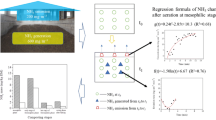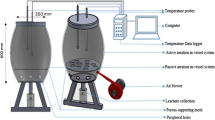Abstract
This chapter reports first results on the performance of a composting reactor with off-gas oxygen levels ≤10%. The low oxygen level is the result of uncoupling the two functions of the airflow: heat removal and oxygen supply. Uncoupling these functions is achieved by cooling and recirculating the gas, in this way reducing off-gas flow and emission of gaseous ammonia. The objective of the research was to identify a control strategy ensuring reactor performance stability, and a sufficient compost quality.
In an 80-li bench-scale composting unit three runs were made with oxygen concentrations of 10% (v/v) (run A), 5% (B) and 1% (C), respectively. Run A was considered the control object; this level is known to operate smoothly. The feed was a mixture of pig faeces and wheat straw 19:1(w/w). Temperature was regulated at 58 °C. It was not possible to reach the set temperature at oxygen levels below 10%, an initial level of 10% was necessary. Once the set temperature was reached, the oxygen level could be lowered.
The loss of ammonia and Ntot, (g-N g−1DM) from the solids was comparable for the three runs. At lower oxygen concentrations however, more ammonia was trapped in the condense: 53% for run A, 60% for B and 77% for C. Compared to run A, the reduction in off-gas was 33% for B and 50% for C. The loss of organic matter was 25% less for B and 33% less for C, but composting time may not have to be increased. The cumulative oxygen consumption after 450 h of composting was comparable for all runs. Apart from small differences in dry matter content, the composts were comparable for all three runs.
Access this chapter
Tax calculation will be finalised at checkout
Purchases are for personal use only
Preview
Unable to display preview. Download preview PDF.
Similar content being viewed by others
References
APHA (1992) Standard methods for the examination of water and wastewater. 18th edn. American Public Health Association, Washington, DC
Derikx PJL, Willers HC, Ten Have PJW (1994) Effect of pH on the behaviour of volatile compounds in organic manures during dry-matter determination. Bioresour Technol 49 (1): 41–45
Finstein MS, Miller FC, Strom PF, MacGregor ST, Psarianos KM (1983) Composting ecosystem management for waste treatment. Bio/Technology 1: 347–353
Hamelers HVM (1993) A theoretical model of composting kinetics. In: Hoitink AJ (ed) Science and engineering of composting: design, environmental, microbial and utilization aspects. Renaissance Publications, Ohio, pp 36–58
Kroodsma W, Ogink NWM, Satter IHG, Willers HC (1998) A technique for direct separation of pig excrements followed by on-farm treatment of the components. Int Conf on Agricultural Engineering, 24–27 Aug 1998, Oslo, Norway, pp 213–214
Richard TL, Walker LP (1998) Temperature kinetics of aerobic solid-state biodegradation. Proc IBE 1: Al0-A30
Richard TL, Walker LP, Gosset JM (1999) The effects of oxygen on solid-state biodegradation kinetics. Proc IBE 2: A22 - A39
Veeken AHM, de Wilde V, Hamelers HVM (1999) Reduction of ammonia emissions during composting by uncoupling of oxygen demand and heat removal. Orbit ‘89, Weimar, Germany, Rhombos, Berlin, pp 111–117
Author information
Authors and Affiliations
Editor information
Editors and Affiliations
Rights and permissions
Copyright information
© 2002 Springer-Verlag Berlin Heidelberg
About this paper
Cite this paper
Rudrum, D.P., Veeken, A.H.M., de Wilde, V., Rulkens, W.H., Hamelers, B.V.M. (2002). Reduction of Ammonia Emission and Waste Gas Volume by Composting at Low Oxygen Pressure. In: Insam, H., Riddech, N., Klammer, S. (eds) Microbiology of Composting. Springer, Berlin, Heidelberg. https://doi.org/10.1007/978-3-662-08724-4_17
Download citation
DOI: https://doi.org/10.1007/978-3-662-08724-4_17
Publisher Name: Springer, Berlin, Heidelberg
Print ISBN: 978-3-642-08705-9
Online ISBN: 978-3-662-08724-4
eBook Packages: Springer Book Archive




